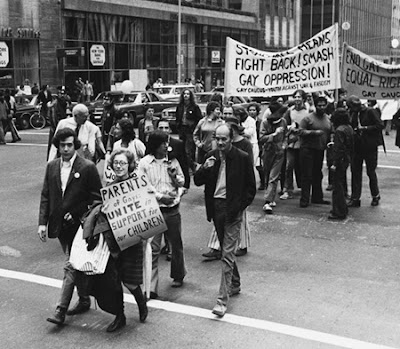Influenced by radical changes in black and women's rights, New York Mattachine's Dick Leitsch started up the Mattachine Action Committee to appease new radical activists. Using this committee Leitsch reinforced that education, not violence, was the key to equality for LGBTQ individuals. However, members of the committee disagreed with Leitsch's peaceful tactics. One member in particular, Jim Fouratt, was so angered by this call for peace that he organized a more radical organization titled the Gay Liberation Front. GLF approached the gay rights movement with a radical perspective very different than the Mattachine's. GLF spent much of its time holding large marches and discussion on homosexuality as a parallel to gender and/or racial discrimination.
Though more generalized in its intentions, the GLF influenced many points of change in gay rights. The Los Angeles GLF's first public action targeted a restaurant in West Hollywood called Barney's Beanery. The restaurant hosted a sign above its entrance that stated (incorrect spelling included), "Fagots Stay Out." In January 1970 GLF members led by Rev. Troy Perry of the LGBT-oriented Metropolitan Community Church began to protest outside the Beanery. Within weeks the protesters had swelled to over one hundred and fifty. Finally after months of protesting the Beanery took down its sign.
In December 1969 New York activists who were frustrated with the unorganized activities of the GLF formed the Gay Activists Alliance (GAA), an organization solely dedicated to homosexual rights. This new group, unlike former ones, had strict rules and procedures. The goal of the GAA was to secure gay rights by using confrontational, militant tactics that went beyond the methods of the homophile radicals of the late 60s.
The most successful method used by the GAA was the 'media zap'. GAA cofounder Marty Robinson believed that the best way to get support was to pressure supposedly liberal politicians. Thus politicians were accosted on the streets and made to answer on opinions of homosexuality and political equality.Such occurrences were largely dramatized and used for media purposes yet proved remarkably effective. Zapping ended up swaying the opinions of several politicians including New York Mayor John V. Lindsay and City Councilwoman Carol Greitzer.
In 1970 the GAA led New York City's first pride parade, and soon after the GAA became so large it formed a headquarters in an abandoned firehouse in the SoHo area of downtown New York.
Parents Get Called In
In 1972 Jeanne Manford wrote a letter to the New York post complaining about how the police didn't intervene to protect her son in a gay protest. Soon enough Jeanne was appearing on television shows as a real life gay parents. In 1972 Jeanne marched with her son in the third annual Christopher Street Liberation Day Parade carrying a poster that read: "Parents of Gays: Unite in Support of Our Children." This was what sparked the creation of PFLAG National-- Parents, Families, and Friends of Lesbians and Gays. Chapters began popping up all over America to give support to parents and family coming to terms with their children's sexual orientation.



I'm not sure if its silly to comment on my own blog, but I must say I was really moved by Mrs. Manfords actions. PFLAG has personally positively affected my life and I'm incredibly grateful for the courage Jeanne Manford faced-- even today most parents are too afraid to do what she did.
ReplyDelete